4 key practices I shared with the Congressional Coal Caucus
By Alex Epstein
Why defend coal?
All fossil fuels—oil, coal, natural gas—are under widespread attack, but coal is the most attacked of all. Even many people who say we need natural gas and or oil over the next several decades will say that we should rapidly eliminate coal. I totally disagree.
We live in a world that needs far more energy—6 billion people use an amount of energy we in the US would consider totally unacceptable—and for billions of people, coal is by far the most cost-effective source of electricity. That’s why it’s so popular in the developing world, especially China.¹
Coal is not only crucial for the developing world, it’s crucial throughout the world. In Europe and in the US coal plants have been saving grids (and therefore economies) from total collapse. And given Europe’s and the US’s unwillingness to properly build out natural gas—especially the pipeline infrastructure it requires—we desperately need our existing coal capacity.²
One of the disadvantages that coal faces is that the coal industry is tiny, and therefore has only a very small political lobby that acts on its behalf. As a result, our legislators don’t hear enough about the importance of coal to preserving our grid and to the well-being of billions of people.
Because I believe coal is crucial for the foreseeable future, and because coal gets so little support, I have created the following guide to defending coal, based on the strategies and messaging I’ve found most effective. I originally created it as part of a recent presentation I gave to the Congressional Coal Caucus.

My guide to defending coal is based on 4 key practices:
- Explaining the broader case for a “fossil future”, including coal.
- Explaining coal’s virtue of resilience.
- Explaining that we are in an “electricity emergency” and the EPA’s war on coal is an existential threat.
- Explaining an alternative policy for addressing long-term CO2 emissions that is not anti-coal.
Explaining the broader case for a “fossil future”, including coal
The benefits of Fossil Fuels
Summary: If 8 billion people are going to have the cost-effective energy they need to flourish—including to master our naturally dangerous climate—in the far greater quantities needed, fossil fuel use needs to increase. Rapidly restricting fossil fuel use, as many experts advocate, is deadly.
- Undeniable energy fact 1: Cost-effective energy is essential to human flourishingCost-effective energy—affordable, reliable, versatile, scalable energy—is essential to human flourishing because it gives us the ability to use machines to become productive and prosperous.
- Undeniable energy fact 2: The world needs much more energyBillions of people lack the cost-effective energy they need to flourish. 3 billion use less electricity than a typical American refrigerator. 1/3 of the world uses wood or dung for heating and cooking. Much more energy is needed.³
- Undeniable energy fact 3: Fossil fuels are uniquely cost-effectiveDespite 100+ years of aggressive competition, fossil fuels provide 80%+ of the world’s energy and they are still growing—especially in the countries most concerned with cost-effective energy. E.g., China.⁴
- Undeniable energy fact 4: Unreliable solar and wind are failing to replace fossil fuelsDespite claims that solar and wind are rapidly replacing fossil fuels, they provide < 5% of world energy—only electricity, ⅕ of energy—and even that depends on huge subsidies and reliable (mostly fossil-fueled) power plants.⁵
- Undeniable energy fact 5: Fossil fuel energy gives us an incredible climate mastery abilityFossil fuels have helped drive down climate disaster deaths by 98% over the last century by powering the amazing machines that protect us against storms, extreme temperatures, and drought.⁶
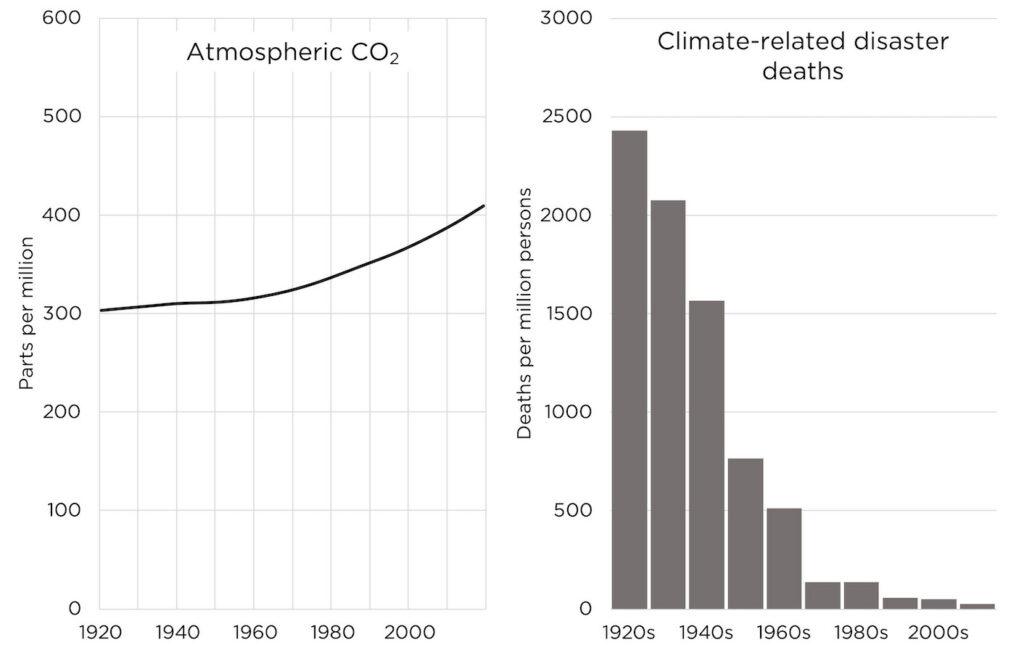
The climate side-effects of fossil fuel use
Summary: If we’re free to use fossil fuels, we’ll continue to have a warming impact that we can master and flourish with. If we follow “net zero” policies we’ll have a less-impacted climate in the short-term, but the climate and the world as a whole will be incomparably less livable, with billions plunging into poverty and premature death.
- Undeniable climate fact: Fossil fuel energy gives us an incredible climate mastery abilityFossil fuels have helped drive down climate disaster deaths by 98% over the last century by powering the amazing machines that protect us against storms, extreme temperatures, and drought.⁷
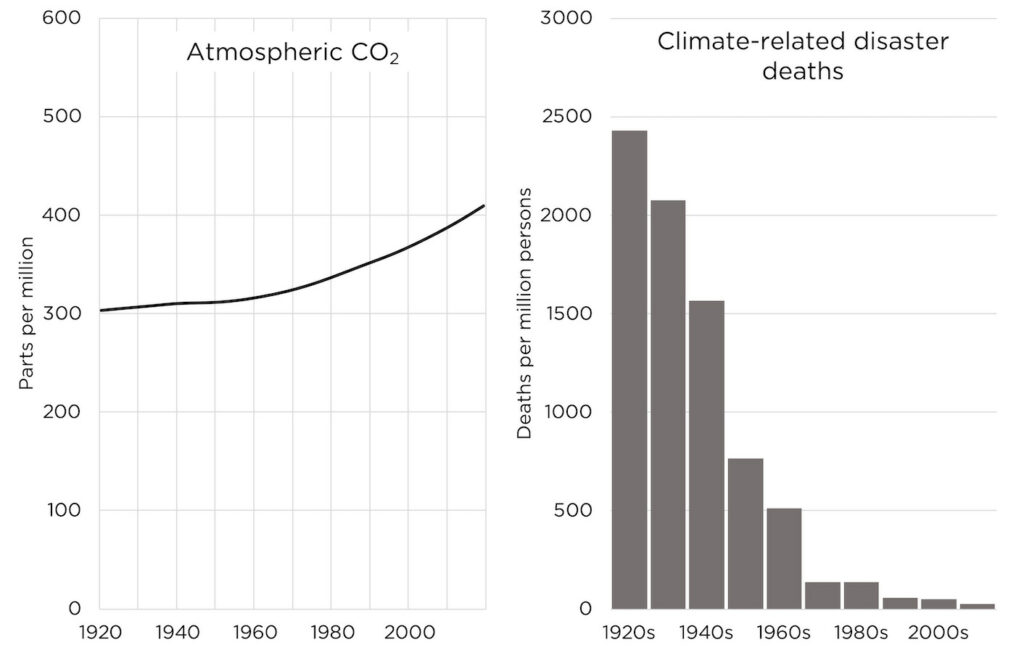
- Undeniable climate fact: CO2 emissions correlate with 1°C warming, and greeningFossil fuels’ CO2 emissions have contributed to the warming of the last 170 years, but that warming has been mild and manageable—1° C. Here’s what that looks like compared to normal temp changes.⁸
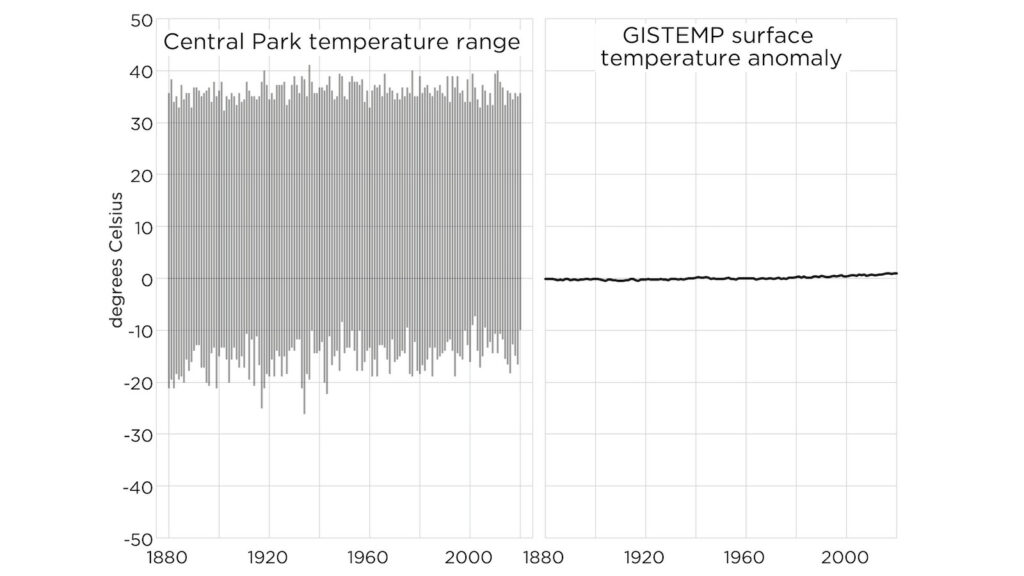
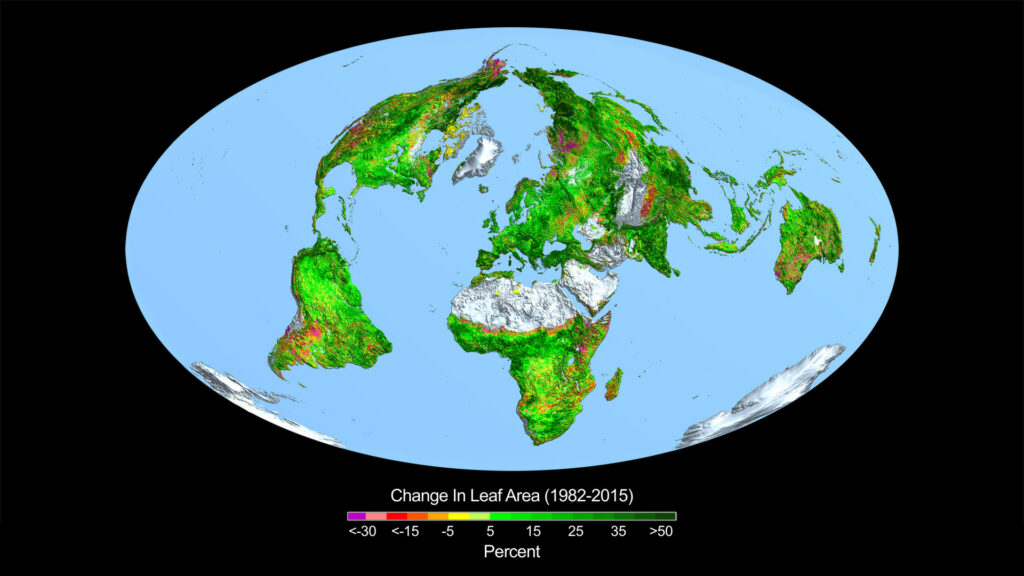
- Undeniable climate fact: Deaths from cold far exceed deaths from heatWhile leading institutions portray a world as increasingly riddled with heat-related death, the fact is that even though Earth has gotten 1°C warmer far more people die from cold than heat (even in India!).⁹
- Undeniable climate fact: Warming from CO2 occurs more in colder placesThe mainstream view in climate science is that more warming will be concentrated in colder places (Northern latitudes) and at colder times (nighttime) and during colder seasons (winter). This is good news.¹⁰

- Undeniable climate fact: Rising CO2 leads to diminishing warmingMainstream climate science is unanimous about a conclusion that the public is, shamefully, not made aware of: the “greenhouse effect” of CO2 is a diminishing effect, with additional CO2 leading to less warming.¹¹
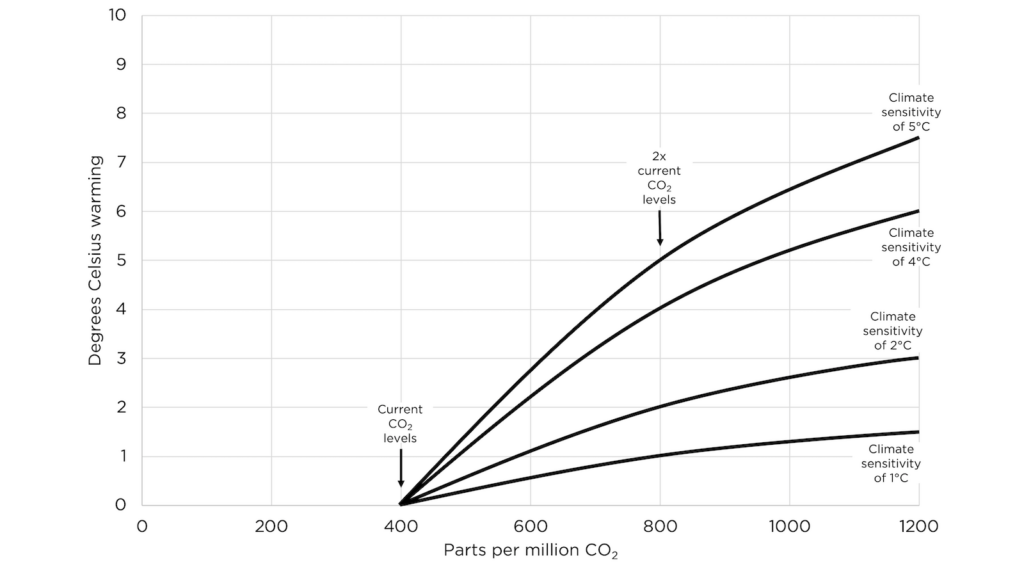
- The only moral and practical way to reduce CO2 emissions is innovation that makes low-carbon energy globally cost-competitive. So long as fossil fuels are the most cost-competitive option for people, especially in developing nations, they will (rightly) choose to emit CO2 vs. plunge even further into poverty.
- So long as America and other wealthy nations follow the anti-development “green energy” movement and the “climate emergency” narrative, they will continue to adopt senseless policies that harm their economies and security while doing nothing to bring about globally cost-competitive low-carbon energy.
The truth about alternatives
Summary: No alternative or combination of alternatives to fossil fuels have any near-term hope of replacing fossil fuels’ unique combination of affordability, reliability, versatility, and scalability in a world that needs far more energy. We should, however, liberate alternatives from any and all restrictions that are preventing them from reaching their full potential.
- Myth: We can rapidly reduce fossil fuels at very low costs.Truth: Fossil fuels are a uniquely cost-effective form of energy, which is why they are 80% of global energy and still growing. Rapidly reducing fossil fuels, in a world that needs far more energy, is catastrophic.¹²
- Myth: Solar and wind are cheap.Truth: Solar and wind are unreliable, parasitical sources of energy that add costs to the grid.Claims of “cheapness” are based on ignoring the full costs of solar and wind—above all the cost of a reliable grid that gives them 24/7 life support.
- Myth: Solar and wind are cheaper than fossil fuels because Lazard’s “Levelized Cost of Energy” (LCOE) is lower for solar and wind.Truth: LCOE, by Lazard’s own admission, doesn’t include many costs of solar and wind—above all the cost of a reliable grid needed for 24/7 life support.¹³
- Myth: Solar and wind are “winning in the marketplace,” out-competing fossil fuels and nuclear with superior economics.Truth: Unreliable, parasitical solar and wind are only “winning” when given massive preferences—mandates, subsidies, and no penalty for unreliability.¹⁴
- Myth: Nuclear is too expensive, so we should use solar and wind instead.Truth: Solar and wind can’t provide reliable energy; nuclear can. And nuclear is only expensive because it has, with the help of many “green” activists, been falsely labeled unsafe and effectively criminalized.
- Myth: Solar and wind will reduce our dependence on adversaries for energy.Truth: If Europe’s level of dependence on Russia for natural gas scares you, know this: America is even more dependent on China for many of the key components of solar panels, wind turbines, and batteries than Europe is on Russia for natural gas.¹⁵
Explaining coal’s virtue of resilience
We need an electric grid that provides power when we need it, even under adverse conditions.
- The disastrous Texas blackouts should teach us that we need power plants that are 1) reliable and 2) resilient. Reliable means: they can produce as much power as we need, when we need it. Resilient means: they can keep producing power even under adverse conditions.¹⁶
- One key to resilience is “on-site fuel storage”—keeping a large amount of fuel at a power plant so that it can produce power even during a supply disruption. The champions at on-site fuel storage are coal and nuclear, which can cheaply keep months of fuel on hand.
- Natural gas is not usually as resilient as coal and nuclear, because natural gas is expensive to store in large quantities. Most natural gas power depends on “just in time” delivery from pipelines. If pipeline transport is disrupted, many natural gas plants will go down.
- To make natural gas more resilient, we need to support the rapid building of new pipelines. Unfortunately, today’s Administration is doing the exact opposite—making it incredibly costly to build gas pipelines, and often preventing them from being built at all.
- Another key to resilience is weatherization—ensuring that plants can handle a wide variety of weather conditions, even unusual ones. For example, the weatherized coal and gas infrastructure in Alberta, Canada was able to handle far colder temps than Texas had during its blackouts.
- Resilience requires reliability. A wind turbine can’t be resilient. Even if, at great cost, it is winterized to withstand low temps, you can’t count on it in any weather conditions, let alone extreme ones. And you can’t count on solar for most of any day, extreme weather or not.
- In fact, wind and solar are particularly bad for extreme weather. Wind works worst when temps are extremely cold or extremely hot. Solar totally fails during any kind of storm, and even for hot days is largely useless because it fades in the late afternoon—when air conditioning is needed most.¹⁷
- Wind and solar are not only non-resilient themselves, their rapid fluctuations create resiliency challenges for reliable power plants. Example: gas plants in Texas had to rapidly ramp down to accommodate high wind before the Texas freeze and then rapidly ramp up to compensate for low wind.¹⁸
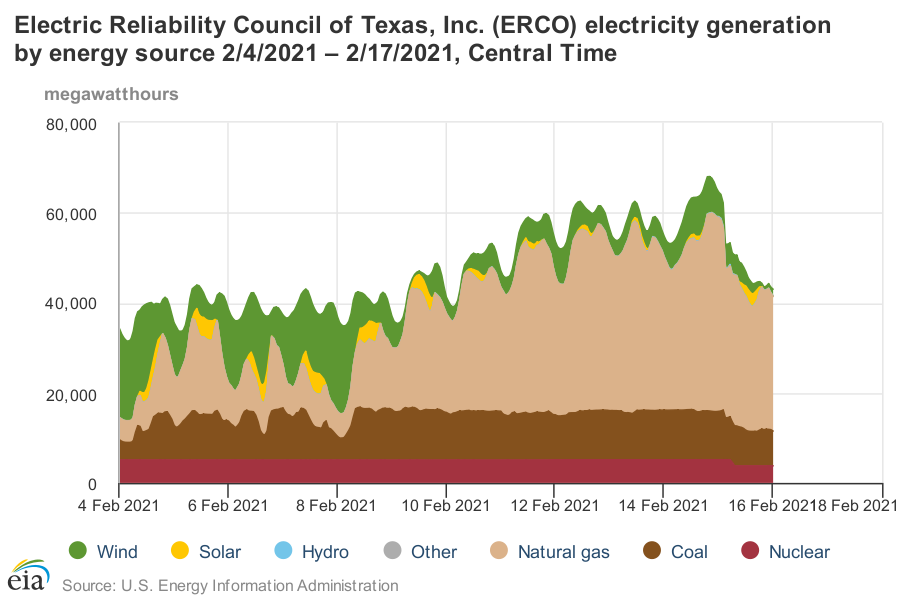
- Wind and solar also cause huge resiliency problems by defunding resiliency. In CA, power-line maintenance funding was cut to pay for solar. In TX, money that could have been used to weatherize plants was used for wind turbines that provided almost no power when it was needed most.
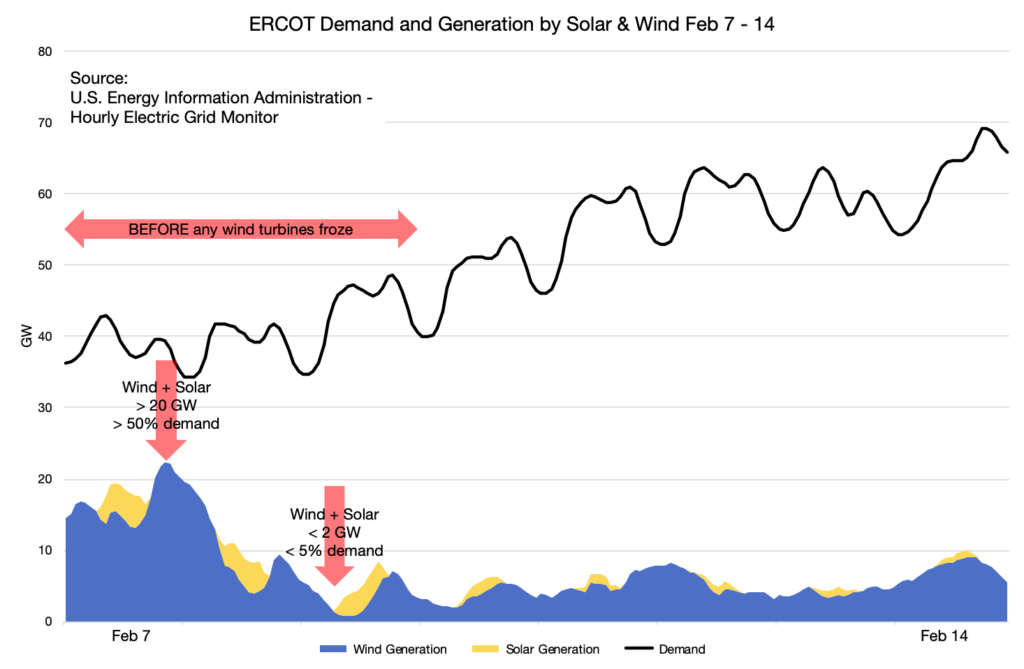
- The Texas blackouts should have sparked a national conversation about resilient power. Instead, we are shutting down more and more coal and nuclear plants, while mandating more resilience-destroying wind and solar.
Explaining that we are in an “electricity emergency” and the EPA’s war on coal is an existential threat
The EPA vs. the grid
We’re in an electricity crisis, with reliable power plants shutting down far faster than they are being built.
And yet the Environmental Protection Agency (EPA) plans to make things much worse with 7 policies that gravely threaten 10-20% of our reliable capacity in the next 7 years.
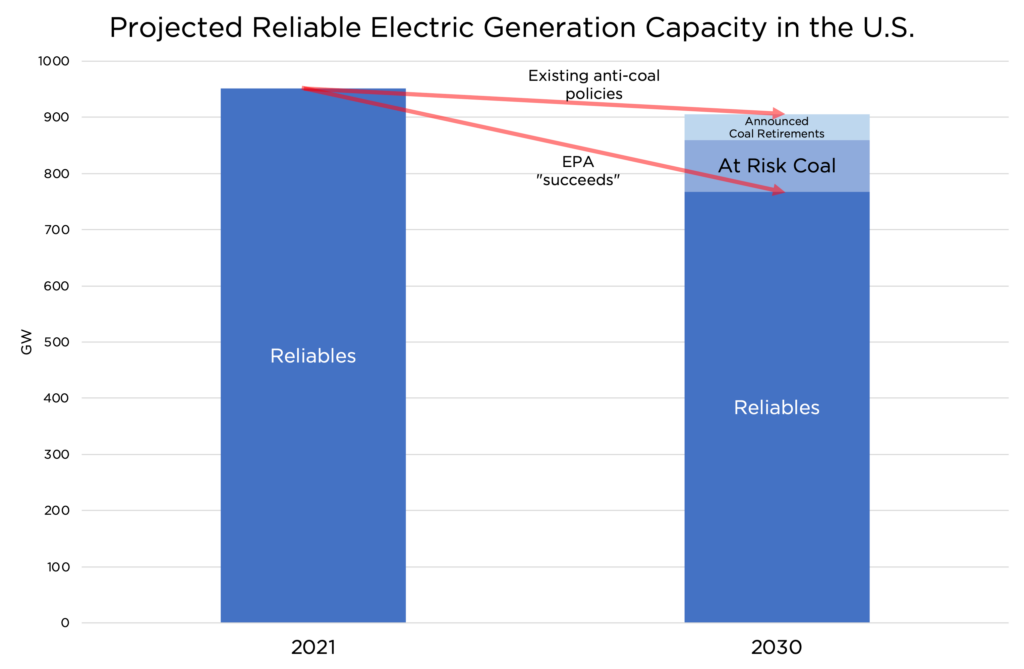
- A reliable grid is foundational to our quality of life. Our lives depend on ultra-reliable electricity for the refrigerators that preserve our food, the water treatment plants that keep our water drinkable, the air conditioning that keeps us cool, the factories that produce our goods, etc.
- Ominously, America’s grid is in its most fragile state in decades. Not only have we witnessed ruinous blackouts in California and Texas, electricity shortages are now routine throughout the US.Federal Electric Reliability Commission (FERC) Commissioner Mark Christie: “We’re heading for a reliability crisis.”¹⁹
- The root cause of the reliability crisis is simple: America is shutting down too many reliable power plants—plants that can be controlled to produce electricity when needed in the exact quantity needed. And it is attempting to replace them with unreliable solar and wind.
- Since at any given time solar and wind can go near zero, using them as replacements for reliable power plants doesn’t work. For example, Texas’ February 2021 disaster was caused by solar and wind disappearing and inadequate investment in reliable power plants and their weatherization.²⁰
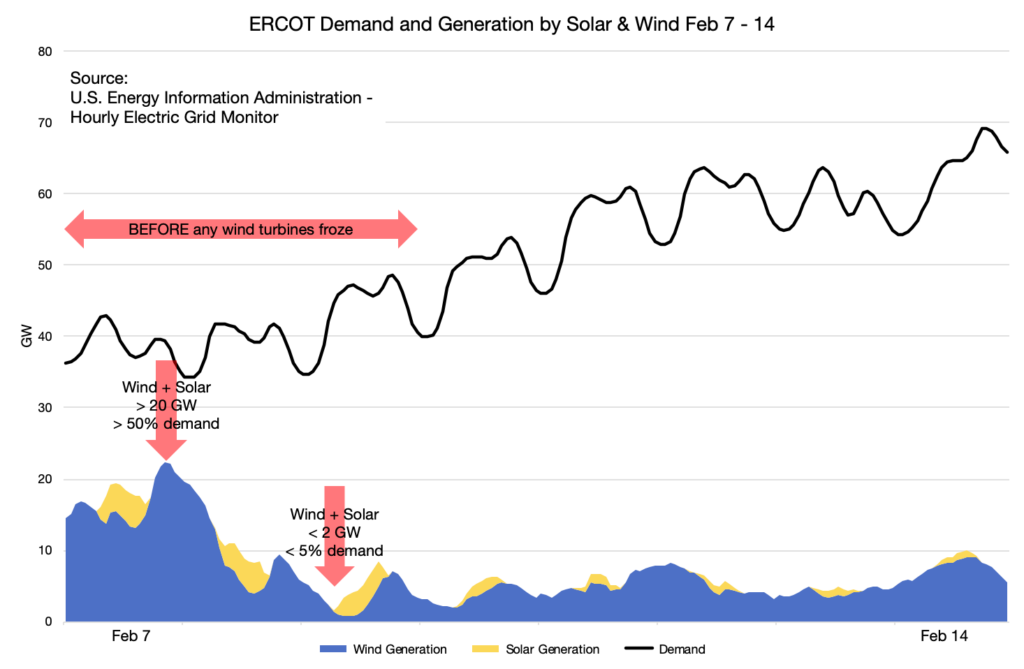
- The most shutdowns over the past 10 years have occurred with reliable, resilient coal plants.When coal plants were at retirement age and replaced more cheaply by gas plants, shutdowns made sense. But most coal was retired early, at great cost—and not sufficiently replaced.
- Today, America’s “coal fleet” has ~200 gigawatts of electricity generation capacity — down ⅓ (>100 gigawatts) from just 10 years ago. It is currently over 20% of our reliable capacity. If we lose any more coal plants without reliable replacements, we could easily see grid collapse.²¹
- Observe the trajectory of American electricity for the next 7 years according to Energy Information Administration announcements: 72 gigawatts of announced reliable power plant shutdowns and only 26 gigawatts of additions.This is really bad. But the Biden EPA plans to make it far, far worse.²²
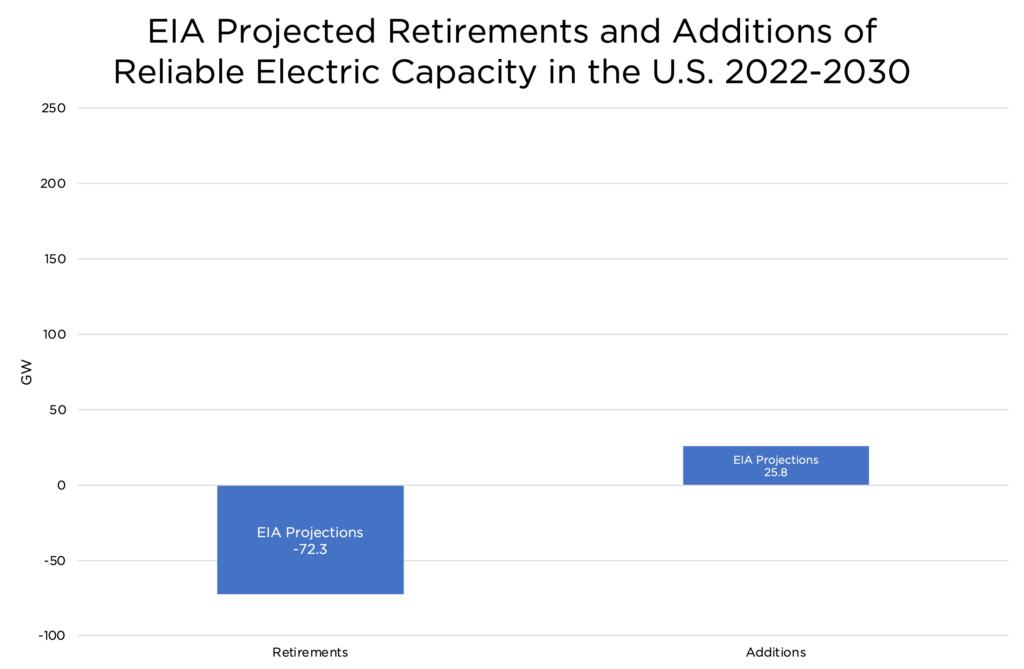
- The Biden administration should recognize the electricity crisis and act immediately to reverse the policies causing the rapid shutdowns of reliable power plants. The EPA should be a major focus, since EPA policies such as the 2015 Mercury and Air Toxics Standards (“MATS”) rule have shut down many plants.
- When considering any changes to regulations of our power plants, which are already clean enough that we have some of the highest air quality in the world, EPA, which is supposed to do “benefit-cost analysis,” should factor in the existential risk of an unreliable grid.
- The consequences of an unreliable grid are catastrophic for the EPA’s focus, human health and environmental quality, killing via lack of heating and air conditioning, preventing water treatment, disrupting emergency services, and by making us all poorer—poverty being the worst thing for health.
- Instead of ordering EPA to stop contributing to the electricity crisis, the Biden administration has used it to threaten as many coal plants as possible by pushing rules that totally violate “benefit-cost analysis”—yielding tiny health benefits while costing us a reliable grid.
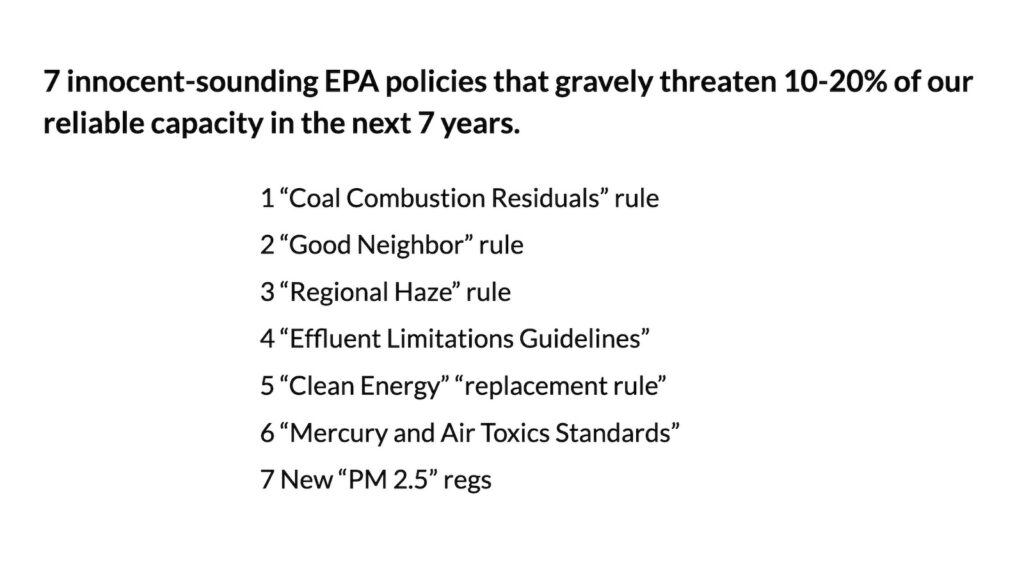
- Thanks largely to EPA, the next 7 years are scheduled to be a bloodbath of reliable capacity retirements. There are 93 gigawatts of announced coal plant retirements, plus up to 92 more gigawatts are at risk of retiring early due to new EPA rules. That’s about ⅕ reliable capacity!²³
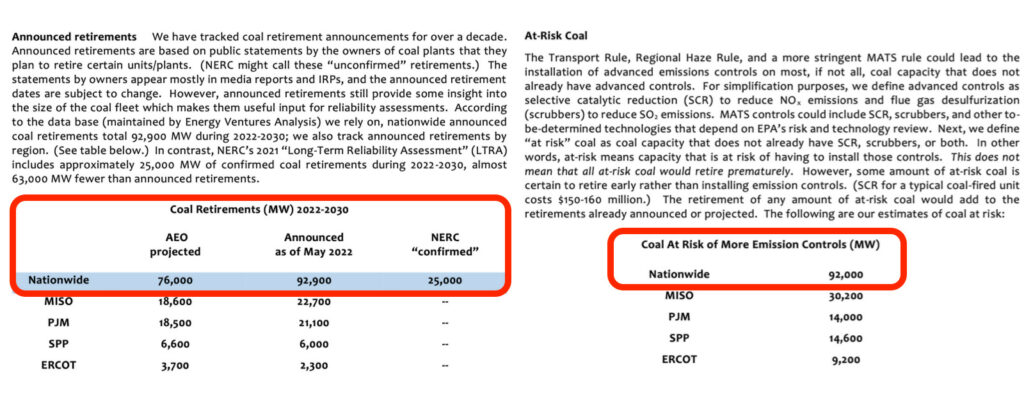
- Consider this graphic of what our grid will look like if the EPA “succeeds” with its anti-coal agenda.If our grid is riddled with reliability problems now, what will it look like when we lose a fifth of our already-insufficient reliable electricity generation?²⁴
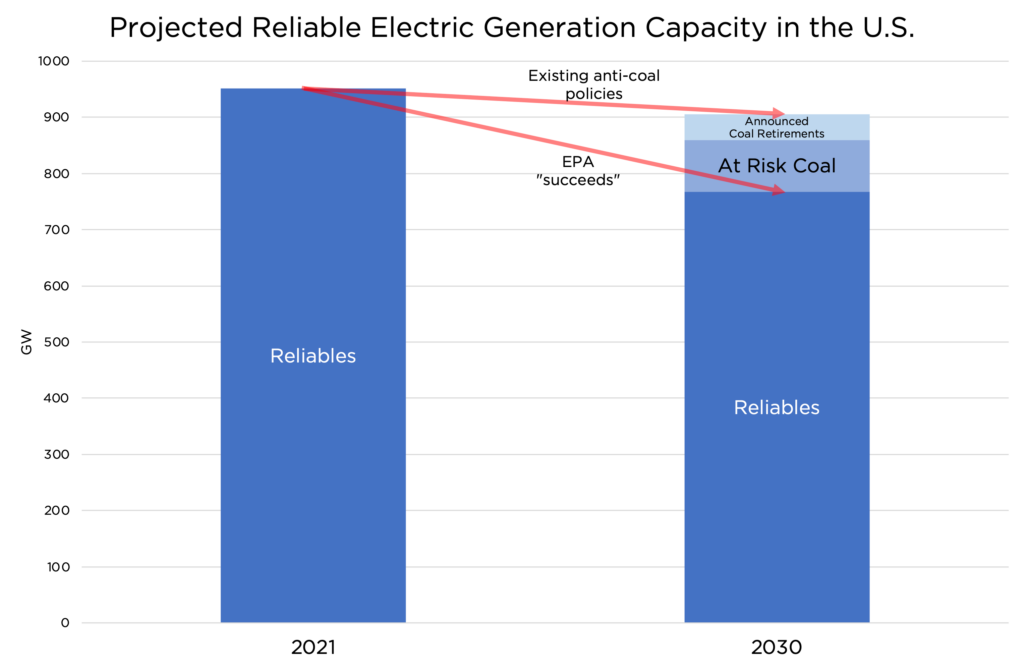
- The secret to the EPA getting away with wrecking our grid is to pass innocent-sounding “health” rules specifically designed to shut down as many coal plants as possible, while totally denying the huge economic and health consequences of an unreliable electric grid.
- The innocent-sounding names of the EPA’s 7-pronged attack on the grid:
1. “Coal Combustion Residuals” rule
2. “Good Neighbor” rule
3. “Regional Haze” rule
4. “Effluent Limitations Guidelines”
5. “Clean Energy” “replacement rule”
6. “Mercury and Air Toxics Standards”
7. New “PM 2.5” regulations - EPA grid attack 1: The Coal Combustion Residuals Rule (CCR)
This rule addresses a legitimate, but not urgent, issue: higher standards for coal waste disposal.But CCR has a deliberately impossible compliance timeline for coal plants, threatening to shut down 42 GW of capacity. - EPA grid attack 2: The “Good Neighbor” RuleThis rule sets ozone levels that many coal power plants can’t afford to comply with and will therefore have to shut down over.This deadly hit to the grid makes no sense; ozone levels are low throughout the US.²⁵
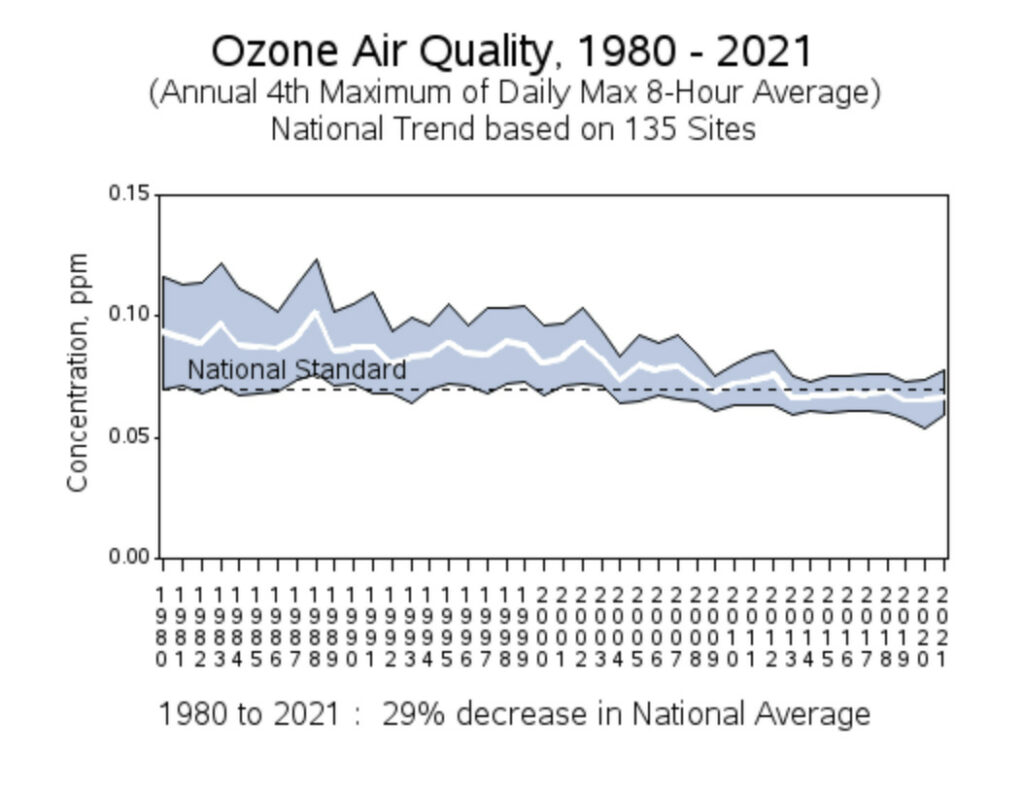
- EPA grid attack 3: The “Regional Haze” RuleThis rule, whose goal is to restore “natural visibility” to certain national parks and wilderness areas by 2064, is being used to try to shut down vital coal plants today.This makes no sense—except to satisfy an anti-coal agenda.²⁶
- EPA grid attack 4: “Effluent Limitations Guidelines”In 2015 the Obama EPA established costly rules for wastewater discharged from power plants. The Trump EPA in 2020 allowed more cost-effective approaches, but the Biden EPA is threatening to create more costly rules again.²⁷
- EPA grid attack 5: “Clean Energy” “replacement rule”With Obama’s “Clean Power Plan” struck down by the Supreme Court, the Biden EPA is working on a “replacement rule.” Given Biden’s intention of eliminating coal, this rule is sure to lead to more shutdowns when we can least afford them.
- EPA grid attack 6: “Mercury and Air Toxics Standards”US mercury emissions are small and have been falling for decades. But in 2012 the Obama EPA created mercury rules that shut down dozens of coal plants. Now EPA is preparing stricter rules, falsely claiming huge net benefits.²⁸
- EPA grid attack 7: New “PM 2.5” regulationsAlthough “particulate matter 2.5” has been decreased to low levels, despite increasing fossil fuel use, the Biden EPA is working on more stringent rules that are likely to shut down even more coal plants when we can least afford it.²⁹
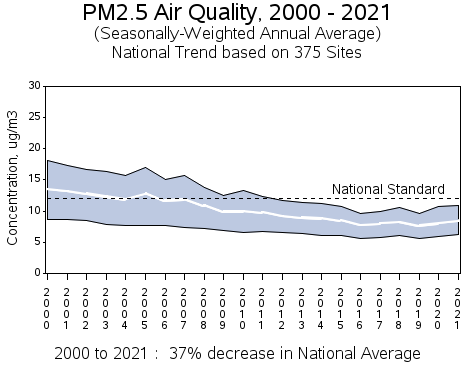
- The Biden EPA is poised to do catastrophic damage to our grid. In the next 7 years, we could easily see over 20% of our reliable capacity destroyed. We must demand that the administration acknowledge our electricity emergency and start doing real cost-benefit analysis.
- To prevent any further worsening of our electricity emergency, the EPA needs to:1. Put a pause on any new rules that could adversely affect reliability
2. Offer extensions to meet existing rule timelines
3. End the “New Source Review” policies that make plant upgrades expensive - Put a pause on any new rules that could adversely affect reliabilityThe rules EPA is considering don’t involve an urgent risk to Americans, whereas any further degradation in reliability is an urgent risk.Until America starts adding reliable capacity EPA needs a pause.
- Offer extensions to meet existing rule timelinesGiven the urgent need to keep reliable power plants open and the difficulties that today’s supply chain crisis is causing for all construction-related projects, EPA should offer power plants extensions on complying with rules.
- End the “New Source Review” policies that make plant upgrades expensive“New Source Review” considers an existing, upgrading plant a “new” plant that then must follow every rule for new power plants. This perversely encourages plants not to make individual upgrades.³⁰
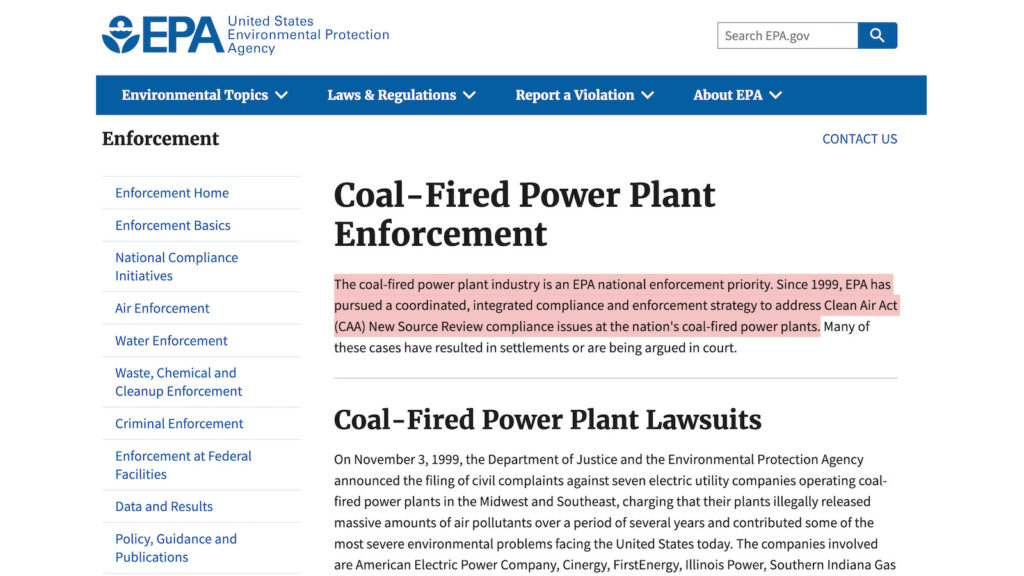
- Once the immediate crisis to our electric grids is defused, we need significant reform of the regulatory apparatus and major legislation to take into account the true cost of regulation and to prevent executive agencies from exercising so much arbitrary power.
- A first step is for the EPA to use a decision-making framework that considers ALL risks and side-effects regulations have, including damage to the economy in general and affordable energy in particular.Had such a framework existed we wouldn’t have today’s electricity emergency.
Explaining an alternative policy for addressing long-term CO2 emissions that is not anti-coal
America is taking a “punish America” approach to reducing CO2, making our energy more expensive and less reliable while China, Russia, and others increase their emissions.
We need a “liberate American innovation” policy instead.
- The only moral and practical way to reduce CO2 emissions is innovation that makes low-carbon energy globally cost-competitive. So long as fossil fuels are the most cost-competitive option for people, especially in developing nations, they will (rightly) choose to emit CO2.
- The US causes < 1/6 of global CO2 emissions—and falling. The main reason global CO2 emissions are rising is because billions of people in the developing world are bringing themselves out of poverty by using fossil fuels to power factories, farms, vehicles, and appliances.³¹
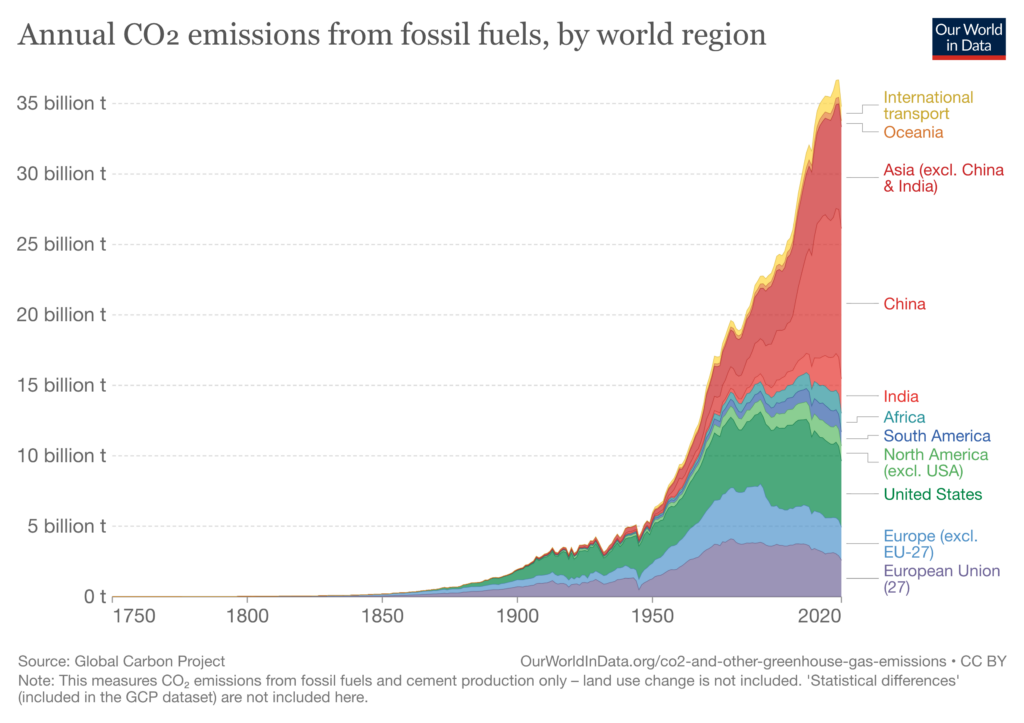
- The developing world overwhelmingly uses fossil fuels because that is by far the lowest-cost way for them to get reliable energy. Unreliable solar and wind can’t come close. That’s why China and India have hundreds of new coal plants in development.³²
- The only way to lower CO2 emissions and benefit America is to promote innovation that makes low-carbon energy truly reliable and low-cost. Are China and India going to stop using fossil fuels so long as they are the lowest-cost option? They won’t and they shouldn’t.
- Instead of low-carbon energy evolving to become more cost-effective than fossil fuels, we are seeing huge government preferences for solar and wind “solutions” that make electricity more expensive and less reliable, while nuclear is stagnant or declining in much of the world.³³
- America’s and other governments’ promotion of non-cost-effective low-carbon energy and impeding of promising low-carbon nuclear energy has led to a situation where there is no globally cost-competitive low-carbon energy on the horizon.
- The only moral and practical way to reduce emissions long-term is liberating innovation that makes low-carbon energy globally cost-competitive—while ending all policies that punish America via rapid short-term emissions reduction.Some key policies👇
- Reject the false idea of “climate emergency.”
Our government’s disastrous anti-fossil fuel policies are justified by the disastrous conflation of “climate impact,” which is real, with “climate emergency,” which is not, given today’s unprecedented safety from climate danger. - Withdraw from the Paris Agreement and encourage others to do the same.
The Paris Agreement is an immoral agreement that calls for rapidly eliminating fossil fuels, which are the only near-term way to provide reliable energy for billions of people at prices they can afford. - Reject and eliminate all carbon taxes.
Carbon taxes increase our energy costs based on the false premise that the “negative externalities” of fossil fuels’ CO2 emissions outweigh the “positive externalities” of the uniquely low-cost, reliable energy they provide for billions. - Amend the Clean Air Act to explicitly reject the bogus “endangerment finding.”
Much of today’s “punish America” CO2 policy is rooted in EPA’s “endangerment finding,” which treats fossil fuel use as a net harm to “public health and welfare” even though it radically improves both. - Decriminalize nuclear energy.The overregulation of low-carbon nuclear verges on criminalization, making nuclear costs 10X higher than they need to be. Decriminalizing nuclear, including radical reform of the Nuclear Regulatory Commission and Environmental Protection Agency, will make energy far cheaper, safer, and cleaner.³⁴
- End all preferences for unreliable electricity.
Today’s electric grids are being ruined by systemic preferences for unreliable electricity, which causes prices to rise and reliability to decline.Eliminating them can help make America a leader in low-cost, reliable electricity. - Allow free-market competition for EVs.
The proper policy toward EVs, which are promising but not cost-effective for the vast majority of Americans, is 1) let them compete on a free market and 2) make sure we have plenty of low-cost, reliable electricity. - Summary: The pro-human CO2 policy is to reduce CO2 emissions long-term through liberating innovation, not punishing America.This will ensure plenty of energy for the foreseeable future and enable truly promising alternatives such as nuclear to be globally cost-competitive.
SHARE
1 IEA – Access to affordable, reliable, sustainable and modern energy for all
Robert Bryce – A Question of Power: Electricity and the Wealth of Nations
Energy Institute – 2023 Statistical Review of World Energy
2 Alex Epstein – The EPA vs. the grid
3 IEA – Access to affordable, reliable, sustainable and modern energy for all
Robert Bryce – A Question of Power: Electricity and the Wealth of Nations
4 Energy Institute – 2023 Statistical Review of World Energy
5 Energy Institute – 2023 Statistical Review of World Energy
6 For every million people on earth, annual deaths from climate-related causes (extreme temperature, drought, flood, storms, wildfires) declined 98%–from an average of 247 per year during the 1920s to 2.5 in per year during the 2010s.
Data on disaster deaths come from EM-DAT, CRED / UCLouvain, Brussels, Belgium – www.emdat.be (D. Guha-Sapir).
Population estimates for the 1920s from the Maddison Database 2010 come from the Groningen Growth and Development Centre, Faculty of Economics and Business at University of Groningen. For years not shown, population is assumed to have grown at a steady rate.
Population estimates for the 2010s come from World Bank Data.
7 For every million people on earth, annual deaths from climate-related causes (extreme temperature, drought, flood, storms, wildfires) declined 98%–from an average of 247 per year during the 1920s to 2.5 in per year during the 2010s.
Data on disaster deaths come from EM-DAT, CRED / UCLouvain, Brussels, Belgium – www.emdat.be (D. Guha-Sapir).
Population estimates for the 1920s from the Maddison Database 2010 come from the Groningen Growth and Development Centre, Faculty of Economics and Business at University of Groningen. For years not shown, population is assumed to have grown at a steady rate.
Population estimates for the 2010s come from World Bank Data.
8 NASA – GISS Surface Temperature Analysis
Regional trends vary, but overall the world’s leaf area increased by 5.4 million square kilometers, or an amazon rainforest worth of greening, between 2000 and 2017 alone with over 1/3 of vegetated land showing an increase while only 5% showed a loss of green vegetation.
“Long-term satellite records reveal a significant global greening of vegetated areas since the 1980s, which recent data suggest has continued past 2010. …
Global vegetation models suggest that CO2 fertilization is the main driver of global vegetation greening.”
Piao, S., Wang, X., Park, T. et al. Characteristics, drivers and feedbacks of global greening. Nat Rev Earth Environ 1, 14–27 (2020).
Bjorn Lomborg: Climate change and deaths from extreme heat and cold
11 Equilibrium climate sensitivity defined as a warming in °C per doubling of greenhouse gas concentrations in the atmosphere. The IPCC estimates it to be between 2.5°C and 4°C. Other analysis suggests it to be below 2°C.
Climate etc. – Important new paper challenges IPCC’s claims about climate sensitivity
12 Energy Institute – 2023 Statistical Review of World Energy
13 Lazard – 2023 Levelized Cost Of Energy+
J.P. Morgan – Growing Pains: The Renewable Transition in Adolescence
14 Alex Epstein – The Myth of Fossil Fuel Subsidies
15 Alex Epstein – How the Biden Administration threatens energy security
16 Alex Epstein – Talking Points on the Texas Electricity Crisis
17 Alex Epstein – Talking Points on Resilience
18 Alex Epstein – Talking Points on the Texas Electricity Crisis
19 America’s Power – What Others Are Saying About the Potential Reliability Crisis
20 Alex Epstein – Talking Points on the Texas Electricity Crisis
Brent Bennett – Forget About What Broke: The Texas Blackout Was Inevitable
U.S. Energy Information Administration – Hourly Electric Grid Monitor
21 U.S. Energy Information Administration – Electric Power Annual
22 U.S. Energy Information Administration – Electric Power Monthly, October 2022
U.S. Energy Information Administration – Electric Power Annual
24 U.S. Energy Information Administration – Electric Power Annual
25 U.S. Environmental Protection Agency – Ozone Trends
26 Louisiana Department of Environmental Quality – Regional Haze Program
27 U.S. Environmental Protection Agency – 2021 Supplemental Steam Electric Rulemaking
28 Competitive Enterprise Institute – EPA Mercury Rule an Inappropriate Exercise of Regulatory Power
29 U.S. Environmental Protection Agency – Particulate Matter (PM2.5) Trends
30 U.S. Environmental Protection Agency – Coal-Fired Power Plant Enforcement
31 Our World in Data – Annual CO₂ emissions from fossil fuels, by world region
The U.S. Energy Information Administration in its reference case projects an overall increase of CO2 emissions for the world while America continues to reduce emissions slightly. As of 2017 US CO2 emissions were less than 15% of the global total.
U.S. EIA International Energy Outlook 2019 reference case
32 As of July 2022, China and India have over 300 coal-fired power plants with a combined capacity of 221 GW planned or under construction.
Global Energy Monitor – Global Coal Plant Tracker
33 World Nuclear Association – Plans For New Reactors Worldwide
U.S. EIA – U.S. nuclear electricity generation continues to decline as more reactors retire
Power Hour – How to liberate nuclear energy, with Robert Zubrin
Share This:
Next Article



